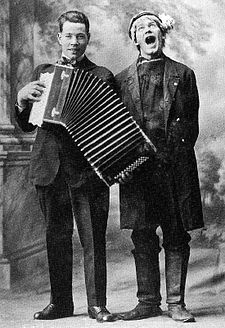Hjalmar Peterson
| Olle i Skratthult | |
|---|---|

L to R: Gustav Nyberg and Olle i Skratthult 1916
|
|
| Born |
Hjalmar Peterson February 7, 1886 Munkfors, Värmland |
| Died | June 24, 1960 (aged 74) Minneapolis, Minnesota |
| Occupation | singer, comedian |
| Spouse(s) | Olga Lindgren, Mora Grace Engebretson |
Hjalmar Peterson was a singer and comedian from Sweden, who achieved great popularity during the 1910s and 1920s. His stage name was Olle i Skratthult (Olle from Laughtersville).
Hjalmar Peterson was born in Munkfors, Värmland on February 7, 1886. After coming to the United States in 1906 and living in Willmar, Minnesota for several years, he eventually settled in Minneapolis. At first Peterson worked as a bricklayer in the new country, but before long he embarked on a career as a professional entertainer. In 1909 he returned to Sweden as a member of the Swedish-American Quartet, and during its two-year tour he gathered the songs, stories and jokes he would later use as a solo performer.
Back in America Peterson adopted the persona of Olle i Skratthult and began performing on the Scandinavian-language vaudeville circuit. Olle was a bondkomiker (peasant comic), and he dressed the part with a blacked-out tooth and straw-colored wig. By 1916 he had a touring group, and the following year he married the company’s leading lady, Olga Lindgren.
Olle i Skratthult was a full-time entertainer for most of his adult life and for many years was the most famous performer in Scandinavian vaudeville. During the 1920s he toured the country with a large band and was enthusiastically greeted by both ethnic and mainstream audiences. His touring company also had several actors. An evening’s entertainment often began with a short play and ended with a public dance. Olle was generally not in the featured work but appeared between acts in olios, during which he told far-fetched stories and sang diverting songs. A full-length theatrical evening was rare unless it was F. A. Dahlgren's musical drama Värmlänningarna (The people of Värmland).
"Last night I decided to try to gain entrance to Tuckerman Hall, and since I did not arrive until 8 o'clock, I would not have been able to get in if it had not been for my press pass. I lost two buttons on my overcoat in the melee, but that did not matter, as long as I finally got a seat — that is I had to be satisfied with standing room in the rear. And, I did something I had never done before, and never expect to do again — unless I go to an "Olle-show" — that is I stood on my two tired feet over two hours — and enjoyed myself. There is a lot of complaining to be heard from theatrical people, to the effect that revenue is falling off and that the radio and the phonographs keep the public at home. Well, the Swedish public at least did not stay at home that night. The hall was packed an hour before the time when it was scheduled to start, and hundreds clamored for admittance in vain. A man, who can attract crowds like that in these days, must be a phenomenon. Of course he does not do all the performing himself; he is ably assisted by his lovely wife, Olga, and by some very clever dancers, and a bunch of virtuosos, who make up the Olle i Skratthult orchestra. It is a splendid aggregation of musicians, to say the least, and I need not add that my tired feet forgot their tired feeling as soon as the first strains from the instruments were heard, and I danced with glee until the "Home, sweet home" gave the signal that the show was at an end."
...
Wikipedia
